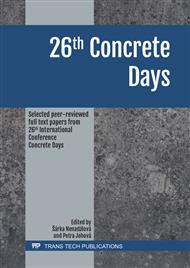p.132
p.140
p.149
p.157
p.163
p.169
p.174
p.180
p.186
Design of Concrete Hinges According to Leonhard
Abstract:
Concrete hinges are characterized by a high load-bearing capacity and deformability. They are nearly maintenance-free and have a high durability if designed and constructed properly. Concrete hinges are perfectly suited to control the flow of forces and to efficiently reduce constraints. The concept more than 130 years old. The first massive joints were developed by Claus Kӧpcke already in 1880. However, due to the difficult construction process, an alternative type of joint was developed, where the concrete contact surface was replaced with embedded lead or steel plates. The breakthrough in this technology was made by Augustine Masnager, who in 1908 developed a durable and easy-to-manufacture reinforced concrete hinge. While Masnager attributed the transfer of the entire load to the reinforcement, French engineer Eugène Freyssinet proved that the throat reinforcement is unnecessary because the load is transmitted through a thin layer of concrete in the throat due to the tri-axial state of stress. This technology is now used throughout Europe and the USA. The best-known experts in this field were Fritz Leonhardt, E.O. Fessler and G.D. Base. Today's design models are based on their research. The vast majority of them are based on empirical approaches and disallow the proper construction of concrete hinges up to the state-of-the-art. For this reason, the research shows effort to modernize them.
Info:
Periodical:
Pages:
163-168
Citation:
Online since:
August 2020
Authors:
Keywords:
Price:
Сopyright:
© 2020 Trans Tech Publications Ltd. All Rights Reserved
Share:
Citation:


